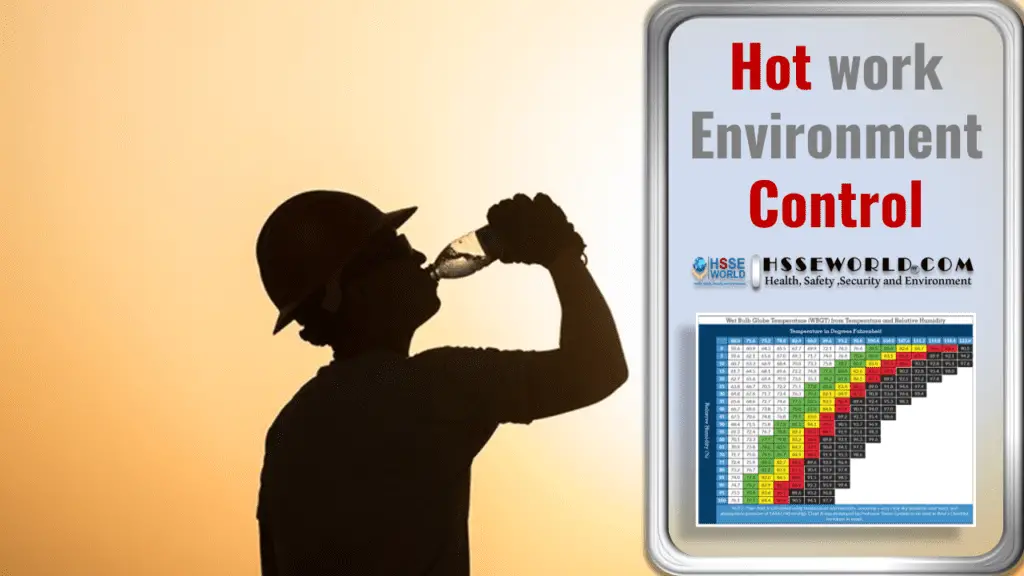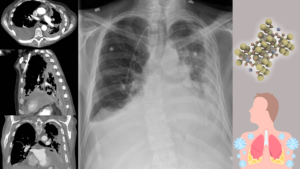Control Hot Work Environment
12 min readMost workers prefer a climate-controlled environment, but that’s not always possible. Foundry workers, pastry bakers, and agricultural workers are just a few of those exposed to hot or humid work environments. Hot Work environments can create health hazards, such as heat stroke, heat exhaustion, and heat cramps. It’s important to understand these heat-related illnesses and know what you can do to prevent them.

Heat Stroke
Heat stroke is the most serious problem associated with working in hot environments. It occurs when the body’s ability to sweat is compromised and becomes inadequate. When the body’s temperature regulatory system fails, there is little warning before victims reach the crisis stage.
According to the National Institute for Occupational Safety & Health (NIOSH), a heat stroke victim’s skin is hot and usually dry, red or spotted. Body temperature is typically 105° F or higher, and the victim is generally confused and delirious. Some victims may experience convulsions or become unconscious. Death can occur if the victim does not receive quick and appropriate treatment.
Any person with symptoms of heat stroke requires immediate medical attention. The victim should be moved to a cool area, thoroughly soaked with cool water, and vigorously fanned to increase cooling. Medical treatment should continue the cooling process and monitor complications that often accompany heat stroke. Early recognition and treatment of heat stroke are the only means of preventing permanent brain damage or death.
Heat Stress: Working Safely in the Heat
What are exposure limits for heat stress?
Exposure limits intended to minimize the risk of heat-related illnesses are set by provincial and territorial governments for most Canadian workplaces, and by Employment and Social Development Canada (ESDC) for workplaces under federal jurisdiction. These agencies generally use the exposure guidelines recommended by the American Conference of Governmental Industrial Hygienists (ACGIH).
The ACGIH gives these limits in units of WBGT (wet bulb globe temperature) degrees Celsius (°C). The WBGT unit takes into account environmental factors, such as air temperature, humidity, and air movement, which contribute to the perception of hotness by people. WBGT values are not the same as humidex values. In some workplace situations, solar load (heat from radiant sources) is also considered in determining the WBGT. More details about WBGT are available below.
The ACGIH publication “2016 TLVs® and BEIs®” (or the most current booklet) provides recommended screening criteria for heat stress exposure for workers (Table 1). This publication and the “Documentation of TLVs® and BEIs®” should be consulted for more detailed information on these screening criteria, categories of work demands, guidelines for limiting heat strain, and heat strain management.
Responding to heat stroke, heat exhaustion
Table 1
ACGIH Screening Criteria for Heat Stress Exposure (WBGT values in °C) for an 8-hour workday five days per week with conventional breaks
| Allocation of Work in a Work/Rest Cycle | Acclimatized | Action Limit (Unacclimatized) | ||||||
|---|---|---|---|---|---|---|---|---|
| Light | Moderate | Heavy | Very Heavy | Light | Moderate | Heavy | Very Heavy | |
| 75-100% | 31.0 | 28.0 | — | — | 28.0 | 25.0 | — | — |
| 50-75% | 31.0 | 29.0 | 27.5 | — | 28.5 | 26.0 | 24.0 | — |
| 25-50% | 32.0 | 30.0 | 29.0 | 28.0 | 29.5 | 27.0 | 25.5 | 24.5 |
| 0-25% | 32.5 | 31.5 | 30.5 | 30.0 | 30.0 | 29.0 | 28.0 | 27.0 |
Notes: Assumes 8-hour workdays in a 5-day workweek with conventional breaks.TLVs assume that workers exposed to these conditions are adequately hydrated, are not taking medication, are wearing lightweight clothing, and are in generally good health. Examples of work loads: Rest – sitting (quietly or with moderate arm movements)Light work – sitting or standing to control machines; performing light hand or arm work (e.g. using a table saw); occasional walking; drivingModerate work – walking about with moderate lifting and pushing or pulling; walking at a moderate pace; e.g. scrubbing in a standing positionHeavy work – pick and shovel work, digging, carrying, pushing/pulling heavy loads; walking at a fast pace; e.g. carpenter sawing by hand very Heavy – very intense activity at fast to maximum pace; e.g. shoveling wet sand
Adapted from: 2016 TLVs® and BEIs® – Threshold Limit Values for Chemical Substances and Physical Agents and Biological Exposure Indices. Cincinnati: American Conference of Governmental Industrial Hygienists (ACGIH), 2016, p. 218.
The ACGIH exposure limits are intended to protect most workers from heat-related illnesses. The limits are higher than they would have been if they had been developed to prevent discomfort. If you are wearing heavier clothing then the exposure limit should be lowered. ACGIH recommendations for such situations are suggested in Table 2.
| Table 2 Correction of TLV for Clothing (Values cannot be added when wearing multiple layers) | |
|---|---|
| Clothing Type | WBGT Correction (°C) |
| Work clothes (long sleeve shirt and pants) | 0 |
| Cloth (woven material) coveralls | 0 |
| SMS (Spunbonded – Meltdown – Spunbonded) polypropylene coveralls | + 0.5 |
| Polyolefin coveralls | + 1 |
| Double-layer woven clothing | + 3 |
| Limited-use vapour-barrier coveralls | + 11 |
| Note: These values are not to be used for completely encapsulating suits. Coveralls assume only modest clothing is underneath, not the second layer of clothing. For example, an acclimatized worker wearing double-layer woven clothing doing moderate work would have a corrected exposure level of: 30.0 + 3 = 33ºC, which would lower his or her allowable exposure to 0-25% work (from 25-50% work) | |
| Adapted from: 2016 TLVs® and BEIs®: Threshold Limit Values for Chemical Substances and Physical Agents and Biological Exposure Indices. Cincinnati, Ohio: American Conference of Governmental Industrial Hygienists, 2016. p. 217 |
How do I use the heat stress exposure table (Table 1)?
As an example, the air temperature was measured by WBGT as 27.0ºC for an 8 hour work period. The worker is not used to hot conditions (i.e., unacclimatized) and is performing moderately heavy cleaning duties (e.g., scrubbing floors and walls). These ACGIH guidelines suggest that an acclimatized worker can do this work for approximately 25 to 50% of an 8 hour period. A “rest break” includes other job duties, being cautious of activities that involve high activity or exertion levels as these activities may not allow a person’s body to cool effectively.
See below for more information about controls and acclimatization.
How can I measure occupational heat exposure?
The feeling of hot or cold depends on:
- Air temperature.
- Relative humidity of the air.
- Presence of hot or cold objects in the surrounding area.
- Presence of air movement (breeze, ventilation).
- Physical exertion.
- Clothing.
Various methods of measuring occupational heat exposure combine these environmental factors to obtain a single number as a measure of overall heat load. The most commonly used measure in the workplace is the wet bulb globe temperature (WBGT) index.
Please Note: This OSH Answers document contains information relating to the prevention of and control of heat-related illnesses.
The Wet Bulb Globe Temperature (WBGT)
The wet bulb globe temperature is calculated using a formula that takes into account air temperature, speed of air movement, radiant heat from hot objects, sunshine, and body cooling due to sweat evaporation.
Air temperature is measured using a conventional thermometer.
The contribution due to radiant heat is measured using a black globe thermometer. A conventional thermometer is inserted through a rubber stopper into a hollow, six-inch diameter copper ball which is coated with flat black paint. The thermometer bulb is positioned at the center of the copper ball. The black globe thermometer normally requires at least 20 minutes to come to an equilibrium reading.
The cooling effect of evaporation and air movement is taken into account using a natural wet-bulb thermometer. A natural wet-bulb thermometer is a conventional thermometer with its bulb wrapped with an absorbent cotton wick. The wick extends 30 to 35 millimeters above the thermometer bulb, and the lower end of the wick is immersed in distilled water. About 25 mm of the moistened wick is exposed between the water and the bulb of the thermometer. The moist wick continuously provides water for evaporation. As with the black globe thermometer, the natural wet-bulb thermometer also requires at least 20 minutes to reach equilibrium.
Two different methods are used to calculate WBGT in the workplace: one for workplaces with direct sunlight, and the other for workplaces without direct sunlight.
When conditions of the workplace fluctuate widely, time-weighted WBGT is often used. The question below “How do I calculate the WBGT Index?” gives worked examples of WBGT calculations. WBGT direct reading meters, often called heat stress analyzers, are also available – these meters give direct WBGT reading and no calculations are necessary.
What control measures can be used to reduce the effects of heat?
The risk of heat-related illnesses can be reduced by:
- Engineering controls to provide a cooler workplace.
- Safe work practices to reduce worker exposure.
- Training employees to recognize and prevent heat illnesses.
Table 3 (below) provides a summary of these controls.
Engineering Controls
Engineering controls are the most effective means of reducing excessive heat exposure. The examples which follow illustrate some engineering approaches to reducing heat exposure.
- Reducing Metabolic Heat Production (heat produced by the body): Automation and mechanization of tasks minimize the need for heavy physical work and the resulting buildup of body heat.
- Reducing the Radiant Heat Emission from Hot Surfaces: Covering hot surfaces with sheets of low emissivity material such as aluminum or paint reduces the amount of heat radiated from this hot surface into the workplace.
- Insulating Hot Surfaces: Insulation reduces the heat exchange between the source of heat and the work environment.
- Shielding: Shields stop radiated heat from reaching workstations. Two types of shields can be used. Stainless steel, aluminum, or other bright metal surfaces reflect heat back towards the source. Absorbent shields, such as a water-cooled jacket made of black-surfaced aluminum, can effectively absorb and carry away heat.
- Ventilation and Air Conditioning: Ventilation, localized air conditioning, and cooled observation booths are commonly used to provide cool workstations. Cooled observation booths allow workers to cool down after brief periods of intense heat exposure while still allowing them to monitor equipment.
- Reducing the Humidity: Air conditioning, dehumidification, and elimination of open hot water baths, drains, and leaky steam valves help reduce humidity.
Personal Protection
Ordinary clothing provides some protection from heat radiated by surrounding hot surfaces. Specially designed heat-protective clothing is available for working in extremely hot conditions. In hot and humid workplaces, light clothing allows maximum skin exposure and efficient body cooling by sweat evaporation.
Workers who move back and forth between very hot, dry indoor environments and cold winter outdoor environments find that long underwear moderates the extremes in temperatures.
Eye protection which absorbs radiation is needed when the work involves very hot objects, such as molten metals and hot ovens.
Work that requires the wearing of impermeable clothing presents an added heat burden as the clothing reduces the body’s ability to dissipate heat. Under such circumstances, it is often necessary to reduce the exposure limit values of WBGT to levels below those appropriate for workers wearing light clothing.
| Table 3 Summary of Control Measures | |
|---|---|
| Methods of Control | Actions |
| Engineering controls | |
| Reduce body heat production | Mechanize tasks. |
| Stop exposure to radiated heat from hot objects | Insulate hot surfaces. Use reflective shields, aprons, and remote controls. |
| Reduce convective heat gain | Lower air temperature. Increase airspeed if air temperature is below 35°C. Increase ventilation. Provide cool observation booths. |
| Increase sweat evaporation | Reduce humidity. Use a fan to increase airspeed (movement). |
| Clothing | |
| Wear loose clothing that permits sweat evaporation but stops radiant heat. Use cooled protective clothing for extreme conditions. | |
| Administrative controls | |
| Acclimatization | Allow sufficient acclimatization period before full workload. |
| Duration of work | Shorten exposure time and use frequent rest breaks. |
| Rest area | Provide cool (air-conditioned) rest-areas. |
| Water | Provide cool drinking water. |
| Pace of Work | If practical, allow workers to set their own pace of work. |
| First aid and medical care | Define emergency procedures. Assign one person trained in first aid to each work shift. Train workers in recognition of symptoms of heat exposure. |
Can we become acclimatized to hot environments?
The body adapts to a new thermal environment by a process called acclimatization. Complete heat acclimatization generally takes six to seven days, but some individuals may need longer. Loss of acclimatization occurs gradually when a person has moved permanently away from a hot environment. However, a decrease in heat tolerance occurs even after a long weekend. As a result of reduced heat tolerance, it is often not advisable for anyone to work under very hot conditions on the first day of the week.
New employees should acclimatize before assuming a full workload. It is advisable to assign about half of the normal workload to a new employee on the first day of work and gradually increased on subsequent days.
Although well-trained, physically fit workers tolerate heat better than people in poor physical condition, fitness and training do not substitute for acclimatization.
Some medications interfere with acclimatization. For example, hypotensives (drugs causing low blood pressure), diuretics, antispasmodics, sedatives, tranquilizers, antidepressants, and amphetamines decrease the body’s ability to cope with the heat. Workers should seek a doctor’s advice on the suitability of a medication for them if they work in hot environments. Consumption of alcohol also interferes with acclimatization.
How can I prevent heat-related illnesses?
If practical, workers in hot environments should be encouraged to set their own work and rest schedules. Infrequent or irregular tasks such as emergency repairs of hot process equipment often result in heat exposure. Experienced workers can often judge heat strain and limit their exposure accordingly. Inexperienced workers may need special attention as they may continue to work beyond the point at which signs of heat strain appear.
People are generally unable to notice their own heat stress-related symptoms. Their survival depends on their coworker’s ability to recognize these symptoms and seek timely first aid and medical help.
Salt and Fluid Supplements: A person working in a very hot environment loses water and salt through sweat. This loss should be compensated by water and salt intake. Fluid intake should equal fluid loss. On average, about one liter of water each hour may be required to replace the fluid loss. Plenty of cool (10-15°C) drinking water should be available on the job site and workers should be encouraged to drink water every 15 to 20 minutes even if they do not feel thirsty. Alcoholic drinks should NEVER be taken as alcohol dehydrates the body.
An acclimatized worker loses relatively little salt in their sweat and, therefore, the salt in the normal diet is usually sufficient to maintain the electrolyte balance in the body fluids. For unacclimatized workers who may sweat continuously and repeatedly, additional salt in the food may be used. Salt tablets are not recommended because the salt does not enter the body system as fast as water or other fluids. Too much salt can cause higher body temperatures, increased thirst, and nausea. Workers on salt-restricted diets should discuss the need for supplementary salt with their doctor.
Sports drinks, fruit juice, etc: Drinks specially designed to replace body fluids and electrolytes may be taken but for most people, they should be used in moderation. They may be of benefit for workers who have very physically active occupations but keep in mind they may add unnecessary sugar or salt to your diet. Fruit juice or sport and electrolyte drinks, diluted to half the strength with water, is an option. Drinks with alcohol or caffeine should never be taken, as they dehydrate the body. For most people, water is the most efficient fluid for re-hydration.
Emergency Action Plan: In extreme environments, an emergency plan is needed. The plan should include procedures for providing affected workers with first aid and medical care.
How do I calculate the WBGT Index?
The wet bulb globe temperature (WBGT) is calculated by using the following equations.
- For outdoors with direct sun exposure:WBGT = 0.7 x Tempwet bulb + 0.2 x Tempglobe + 0.1 x Tempair
- For indoors or outdoors without direct sun exposure:WBGT = 0.7 x Tempwet bulb + 0.3 x Tempglobe
where:
Tempwet bulb natural wet bulb temperature is measured by using a thermometer whose bulb is covered with wet cotton cloth and is cooled by the natural air movement
Tempglobe temperature measured using a black globe thermometer
Tempair temperature measured using a conventional thermometer
All temperatures are to be expressed in °C.
Example
Workers employed in an outdoor workplace with direct exposure to the sun. Measurement of workplace conditions produced the following results.
Tempwet bulb = 24°C
Tempglobe = 42°C
Tempair = 40°C
WBGT = 0.7 x 24 + 0.2 x 42 + 0.1 x 40 = 29.2°C
Time-Weighted Average (TWA)
When thermal conditions of the workplace fluctuate widely, time-weighted average (TWA) WBGT is used to assess heat exposure.

WBGT1,WBGT2, etc. the wet bulb globe temperatures measured or calculated
t1, t2, etc. the elapsed time spent in the corresponding conditions described by WBGT1, WBGT2, etc., respectively.
Example
Measurement and/or calculation of WBGT during a two-hour job produced the following results.
| Exposure duration (hours) | WBGT (°C) |
|---|---|
| 0.5 | 25 |
| 1.0 | 27 |
| 0.5 | 28 |
These data would yield the following time-weighted average.





